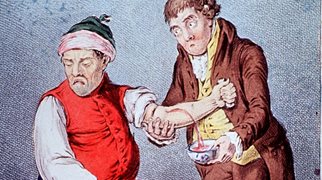Playing is Learning
Conventional medical treatments in the 1850s
October 11th, 2016
| Ads | ||
|
Play the Challenge
|
||
|
A New Word is Coined A new Character is revealed A new Game is Afoot |
An Edutainment Adventure Based on Three Rounds of Investigations
|
|
|
Welcome to the World of PROFESsee™by seeCOSM™ PROFESsee™ is my title. I am the perpetual learner, in pursuit of knowledge, wisdom and truth. I derived my name from professor |
 |
|
|
Hindsight is truly 20/20. I can imagine you saying, “And they went through that?” after reading through this article. But that was their reality then. Sometimes patients were in essence guinea pigs for physicians whose theories were from a-ha moments. The 1850s for conventional medicine was a period predominantly marked by pseudoscience, assumptions, trial and error (bingo!), and one shoe fits all approach. Let’s examine some of these methods. Homeopathy Homeopathy inspired by Samuel Hahnemann from 1796 was as contentious as any medical therapy during that time. While it seemed scientific, at least in approach, it was a treatment literally stumbled upon from translating a book by another doctor. Homeopathy is based on the principle of similia similibus curentur (like cures like). It states that the causative agent of a disease in healthy people would be the cure for the same disease in sick people. Bloodletting Another common medical treatment in the 1850s was bloodletting, which you guessed right, involved blood – sometimes plenty of blood. I can just imagine having a conversation in the 1850s that goes thus: Me: Doctor, I have these symptoms (lists symptoms) Doctor: Those are the signs of X, Y and Z diseases Me: So what shall we do? Doctor: We will have to nick some of your veins and remove some blood. Me: Just do it. I can now imagine having that conversation today. As soon as he has mentioned blood and my veins in the same sentence, it’s going to be an emphatic “No!” So back then, bloodletting was a panacea for all diseases, and everyone was naturally open to it. Iodine treatment for goiter While most of the treatments were pseudoscience, one treatment stood out for the way of discovery – backed by fact, and scientific approach. The discovery of iodine as a treatment for goiter started with the discovery of iodine as an element in 1811. However, it wasn’t until 1819, that JF Coindet, a Swiss physician treated 150 goiter patients with iodine. He gave each patient a 250mg/day dosage, and within a week, the goiter growths were shrinking in size. This wasn’t accidental or an assumed notion; he published his findings in 1820. Other treatment popular at this time includes applying plaster cast on the penis to prevent masturbation, and the use of orange, lime and lemons to cure scurvy. All treatments listed above goes to show the long way medicine has come in treating diseases. Can you Zoom and find the correct answer? Image courtesy of: http://www.history.com/news/a-brief-history-of-bloodletting |
||
Latest News / Events
E-mail [email protected]
The Professee™ Newsletter Beta
http://www.seecosm.com/
http://www.seecosm.com/

